Significant genetic improvements can be achieved through artificial insemination (AI), and AI has greatly enhanced the US cattle industry. Slow adoption of AI by beef producers has been well documented, and the main reasons identified are usually labor, time, facilities, and ability to accurately perform heat detecting.1 Estrous synchronization is a tool that is commonly used in tandem with AI and may be used to synchronize either estrus or ovulation. Synchronization can help offset some of the labor and time commitments associated with heat detection, facilitating the breeding of multiple heifers in a short time period, reducing labor needs, and shortening calving intervals. In addition, ovulation synchronization protocols remove heat detection to further reduce time and labor expense. For a synchronization protocol to be successful, it must first regress the corpus luteum (CL), then promote the growth of new follicles and induce estrus or ovulation. Combination AI and synchronization programs with virgin heifers offer several advantages over traditional management with a bull in a mature cowherd:
- Working with smaller groups, allows a new AI user to start gradually
- The wealth of genetic information available for selecting AI sires decreases the chances of calving difficulty
- Synchronizing heifers shortens the calving season and allows for efficient use of labor
- Genetic selection tools enable even commercial producers to experience rapid genetic change
- Heifers should also be the most fertile animals with the highest conception rate in a herd
Estrous Synchronization Protocols
Different pharmacological products are available to synchronize estrus in beef cattle. Those products are broken down by class and listed in table 1. Estrous synchronization protocols can be broken down into three different classes: (1) heat detect and breed, (2) timed-artificial insemination (TAI), and (3) combination of heat detection and TAI. The heat detect and breed class is the conventional method of choice for most AI users. However, for those operations where time and labor may not be consistent, TAI or a combination of TAI and heat detection can be very effective. Timed-artificial insemination attempts to synchronize ovulation and allows producers to schedule when they want to breed.
Table 1. Pharmacological products used in estrous synchronization of beef cattle.
| Classes of Compounds | Product Name | Dose, Delivery Method | Action |
| Gonadotropin Releasing Hormone (GnRH, keep refrigerated) | Release of LH and formation of Corpus Luteum | ||
| Cystorelin | 2 ml, i.m. | ||
| Fertagyl | 2 ml, i.m. | ||
| Factrel | 2 ml, i.m. | ||
| Ova-Cyst | 5 ml, i.m. | ||
| Progestins | Imitate Corpus Luteum | ||
| Melengestrol Acetate (MGA) | 0.5 mg/head/day orally | ||
| Control Internal Drug Release (CIDR) | 7 days intravaginally | ||
| Prostaglandins (PGF2) | Regress Corpus Luteum | ||
| EstroPLAN | 2 ml, i.m. | ||
| Estrumate | 2 ml, i.m. | ||
| In-Synch | 5 ml, i.m. | ||
| Lutalyse | 5 ml, i.m. | ||
| Prostamate | 5 ml, i.m. |
Prostaglandins (PG)
Prostaglandin products are effective luteolytic compounds. It is imperative these compounds be administered to cycling heifers exhibiting a functional CL (days 6-18 of a heat cycle), and it will cause the CL to regress. The estrous cycle of the heifer is conventionally eighteen to twenty-one days. If we break a typical cow herd by stage of the estrous cycle, you would assume equal distribution across the twenty-one-day period. Below is how each group would respond to PG administration:
- Day 1-5: Heifers do not have a functional CL, and will not respond to treatment (why we detect heat for five days in figure 1).
- Day 6-18: Heifers have an active CL and will respond to treatment, expressing heat between day two and five after administration.
- Day 18-21: Heifers are naturally regressing a CL and will express heat without administration of prostaglandin. These heifers will express heat within forty-eight hours of administration.
Given the above information, you see that approximately two-thirds of the cycling heifers will express heat within two to five days after administration of prostaglandin.
Progestin and Prostaglandin Combination Treatments
Progesterone is considered the hormone responsible for maintaining pregnancy. Part of the maintenance of pregnancy is also the prevention of estrus. Melengestrol acetate (MGA) at a dosage of 0.5 mg/head per day and controlled internal drug release (CIDR) are examples of progestin products commercially available for use in heifers. These products used in combination with PG are very effective in synchronizing estrus and ovulation. Another commonly used product is gonadotropin-releasing hormone (GnRH), which stimulates a dominant follicle to ovulate. The protocols below have been developed through many years of research and experience. Timing or dosage of drug administration in these protocols should not be adjusted without seeking advice from your local veterinarian or someone with significant experience synchronizing estrus.
Heat Detection Protocols
One-Shot Prostaglandin Protocol (2)
The one-shot prostaglandin protocol is a very basic protocol in which heifers are heat detected for twelve days. On the fifth day of heat detection, one shot of PG is given and the heifers that respond will come in heat in three to five days (figure 1). Heifers that have a functional CL greater than five days old will respond to this protocol.
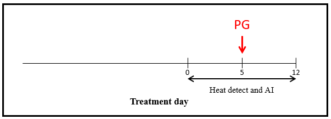
Figure 1. One-Shot Prostaglandin (PGF2) Protocol for artificial insemination (AI). Image credit: Matthew Burns, Clemson University.
7-Day CIDR + PG (2)
The CIDR is inserted intravaginally for seven days. On day seven, the CIDR is removed and an injection of PG is given. From day 7-12, heats are observed, and cattle are bred twelve hours after standing heat (figure 2). The CIDR added to this protocol helps those heifers that did not have at least a five-day old CL. It also decreases the number of days for heat detection.
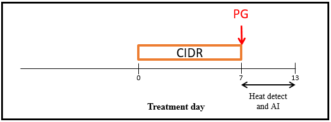
Figure 2. Controlled Internal Drug Release (CIDR) combined with prostaglandin (PGF2) for artificial insemination (AI). Image credit: Matthew Burns, Clemson University.
MGA + PG (2)
MGA is a feed additive progestin product. MGA is very similar to the CIDR; however, the duration for treatment varies by seven days. Heifers coming off of MGA have a first heat that is infertile. For this reason, there is a nineteen-day lag between MGA and the PG shot (figure 3). MGA is not labeled for use in cows.
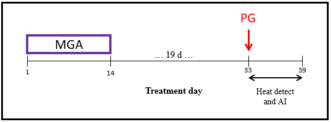
Figure 3. Melengestrol Acetate (MGA) combined with prostaglandin (PGF2) for artificial insemination. Image credit: Matthew Burns, Clemson University.
Heat Detect and TAI Combination Protocols
Select-Synch + CIDR (2)
This protocol uses several different pharmacological products to synchronize ovulation (figure 4). The cost is higher, but labor to detect estrus is reduced.
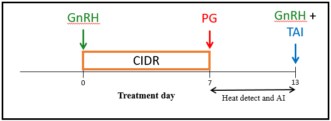
Figure 4. Gonadotropin releasing hormone (GnRH), controlled internal drug release (CIDR), and prostaglandin (PGF2) protocol for synchronizing estrus for artificial insemination (AI). Image credit: Matthew Burns, Clemson University.
MGA – PG (2)
This protocol is for operations that have ample bunk space to feed heifers to make sure each heifer is getting an effective dose of MGA. This protocol has the same 19-day lag as the MGA + PG heat detect protocol due to the infertile first cycle, but a shorter heat detect and AI window (figure 5). Heifers may be bred and given a GnRH injection seventy-two hours after the PG injection.
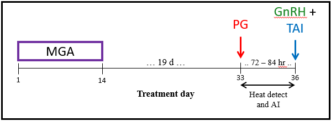
Figure 5. Melengestrol Acetate (MGA), prostaglandin (PGF2), and gonadotropin releasing hormone (GnRH) protocol for artificial insemination. Image credit: Matthew Burns, Clemson University.
Fixed-Time AI Protocols
Select-Synch + CIDR and TAI (2)
This protocol uses heat detection for three days to breed any heifers that may come in early and then TAI for the remaining seventy-two to eighty-four hours after CIDR removal and PG injection (figure 6).
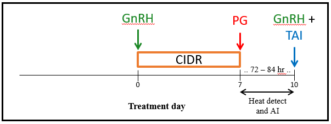
Figure 6. Gonadotropin releasing hormone (GnRH), controlled internal drug release (CIDR), and prostaglandin (PGF2) protocol for synchronizing estrus for artificial insemination (AI). Image credit: Matthew Burns, Clemson University.
MGA – PG + TAI (2)
This protocol is for operations that have ample bunk space to feed heifers and make sure each heifer is getting an effective dose of MGA. This protocol allows for three days of heat detection and AI, followed by a final TAI seventy-two to eighty-four hours after PG injection (figure 7).
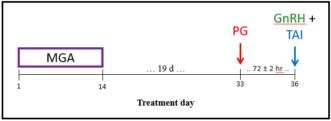
Figure 7. Melengestrol Acetate (MGA), prostaglandin (PGF2), and gonadotropin releasing hormone (GnRH) protocol for artificial insemination. Image credit: Matthew Burns, Clemson University.
14-Day CIDR – PG (2)
This protocol is very similar to the MGA protocol listed above. However, duration between CIDR removal and PG injection is shorter due to faster clearance of progestin from a CIDR (figure 8). For operations that do not have adequate bunk space to feed and monitor MGA intake, this protocol is a good option.
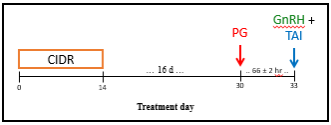
Figure 8. Controlled internal drug release (CIDR), prostaglandin (PGF2), and Gonadotropin releasing hormone (GnRH) protocol for synchronizing estrus for artificial insemination (AI). Image credit: Matthew Burns, Clemson University.
Utilizing artificial insemination and estrous synchronization increases the genetic and production options available to producers. Following these programs, we recommend waiting ten days before turning in the natural service sire (this time allows for determining AI sire calves vs. natural service sire calves during calving season). Most commercial producers will utilize some version of a natural service sire to complete the breeding season. However, if increasing the number of AI sired calves is a high priority, consideration can be given to utilizing heat detection starting on day sixteen after the initial AI (especially true when using any of the TAI programs). Before you begin a 100% AI program, consult with your Extension Specialist or veterinarian to ensure you have a good plan to execute. It may be advantageous to your operation to utilize estrous synchronization and natural service. In addition to or in lieu of AI, the above protocols can also be utilized before turning bulls out, although the number of heifers per bull may need to be reduced to allow the bull to naturally cover heifers in a short amount of time. If monitoring of breeding dates is important, these bulls might be equipped with chin-ball markers to determine which heifers were bred naturally.
References Cited
- [USDA] US Department of Agriculture, Animal and Plant Health Inspection Service. National animal health monitoring system survey: Beef cow-calf studies. Washington (DC): USDA; 2007 [modified 2019 Feb 11; accessed 2019 Aug]. https://www.aphis.usda.gov/aphis/ourfocus/animalhealth/monitoring-and-surveillance/nahms/nahms_beef_cowcalf_studies.
Additional Resources
Burns M. Steps to successful reproductive management in beef cattle. Land-Grant Press by Clemson Extension. 2019; LGP 1005: http://lgpress.clemson.edu/publication/steps-to-successful-reproductive-management-in-beef-cattle.
Nebraska Extension, Institute of Agriculture and Natural Resources. Applied reproductive strategies in beef cattle. Lincoln (NE): University of Nebraska-Lincoln; c2019 [accessed 2019 Aug]. https://beefrepro.org/arsbc/.

